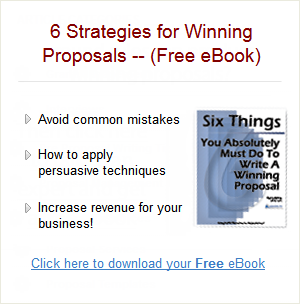Who Are Your Readers: the User Buyer
I recently posted an article on the four different “types” of readers in any give proposal evaluation scenario. Last time out, I talked about the “Economic” buyer. This time I’ll focus on a second category—the “User” buyer.
User buyers are the ones who will ultimately use whatever it is you offer. If they have a vote then you need to pay very specific attention to their needs, and make sure you address them. These people are pretty sensitive; they often believe (justifiably) that management buys stuff they will have to use that will not really meet their needs. Their natural inclination will be to be very suspicious of what you’re offering, because they have been handed useless stuff in the past.
Who they are and what they look for. User Buyers are those who will manage or will be the end-users of the project, product or service you are proposing. A good example of a user buyer—and one who often serves on evaluation panels—is an operations person who will work any facility you propose to design. She will be scouring your proposal for signs that you understand and have addressed her needs.
If, for example, you are proposing to design a water treatment plant, the ops person will be reading to see if you have designed the plant to make it easy to operate and maintain. She will not be looking at the elegance of your engineering design. She’ll want to know that if she turns on a faucet here the water will come out there, where it’s easy to access.
In many cases, you will propose on public works projects, which means that the general public will be the ultimate users of the end product. You must address the needs and concerns of this group of people as well, because someone on the evaluation panel will be looking out for those interests.
And finally, your client’s project manager fits into this category. He will be using your project management services, and will want to feel confident that you will not make him look bad by managing the project poorly.
In general, user buyers will look for evidence of your competence, how well you understand their needs and have come up with ways to resolve them, and how easy you will be to work with.
How to write for them. Since there may be many user buyers with many agendas, you often won’t be able to address all their needs in one section of your proposal. This means you’ll have to touch on them whenever the opportunity arises in sections throughout your proposal.
User buyers will know in which section their concerns are most likely to be addressed; your job is to figure out where you think they’ll be looking. To do this, list their concerns, and then determine in which section (from your proposal outline) it belongs.
User buyers often jump around the proposal, looking for areas of interest. They will usually read the executive summary and major section summaries. Then they will skim the proposal, searching for evidence that you have hit their hot buttons. Your job is to make it easy for them to find what they’re looking for as they skim. Here are some ways to do that:
- Use theme-based headings (“Our team understands the complexities of designing a user-friendly parking control system” rather than simply “Project Team”).
- Use bullets to make key points easy to see.
- Use call-out boxes to emphasize important points you want to make.
- Use non-technical graphics that convey a concept, and are not just “pretty pictures.” Also, make sure each has an action caption that ties the graphic to a key proposal theme.
Finally, hit on their key issues and highlight the benefits of your solution. This will make sure they get the idea that you are as concerned about their needs as about any other’s.

